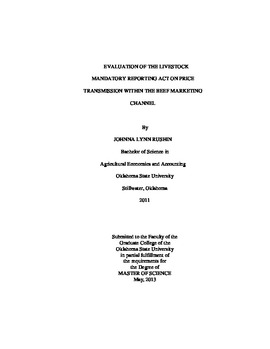| dc.contributor.advisor | Chung, Chanjin | |
| dc.contributor.author | Rushin, Johnna Lynn | |
| dc.date.accessioned | 2014-09-24T14:18:15Z | |
| dc.date.available | 2014-09-24T14:18:15Z | |
| dc.date.issued | 2013-05-01 | |
| dc.identifier.uri | https://hdl.handle.net/11244/11121 | |
| dc.description.abstract | This paper evaluates the impacts of the Livestock Mandatory Price Reporting Act (LMRA) on price transmission within the beef marketing channel. Limited empirical studies have examined the effectiveness of the LMRA. The data is split into a pre and post period. Nonlinearity testing finds existence of thresholds in both periods. Thus, we use a threshold error correction model. Two regimes (based off of a threshold value), "IN" and "OUT", were set up. Interestingly, the percentage of observations in the inside regime decreases in the post period as compared to the pre period. Parameter estimates for the retail level in both periods show significant dynamic relationships and appear to show that price adjustments occur more instantaneously inside the threshold. Short-run asymmetry tests indicate the presence of short run asymmetries in the retail-wholesale and retail-farm price relationships in the post-LMRA period. No short run asymmetries on price variables appear to be present in the pre-LMRA period in all price relationships. Adjustment path testing indicates that all price relationships in the pre period experience different adjustment speeds for negative and positive deviations, however, only the wholesale-farm relationship shows a significantly different adjustment speed in the post period. A comparison of parameter estimates between a standard error correction model and a threshold error correction model is used to determine quickness of deviation adjustment speed. For the wholesale-farm price relationship, in both symmetric and asymmetric specifications, deviations appear to adjust faster in the threshold error correction model in the pre period. For the same relationship in the post period, deviations appear to adjust faster in the standard error correction model. Lastly, the process is tested and run again using a truncated data set to mitigate the price volatility that is apparent after 2006. This run shows no nonlinearities and thus uses a standard error correction model. | |
| dc.format | application/pdf | |
| dc.language | en_US | |
| dc.publisher | Oklahoma State University | |
| dc.rights | Copyright is held by the author who has granted the Oklahoma State University Library the non-exclusive right to share this material in its institutional repository. Contact Digital Library Services at lib-dls@okstate.edu or 405-744-9161 for the permission policy on the use, reproduction or distribution of this material. | |
| dc.title | Evaluation of the Livestock Mandatory Price Reporting Act on Price Transmission Within the Beef Marketing Channel | |
| dc.type | text | |
| dc.contributor.committeeMember | Adam, Brian D. | |
| dc.contributor.committeeMember | Peel, Derrell | |
| osu.filename | Rushin_okstate_0664M_12800.pdf | |
| osu.accesstype | Open Access | |
| dc.description.department | Agricultural Economics | |
| dc.type.genre | Thesis | |
